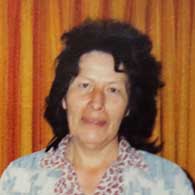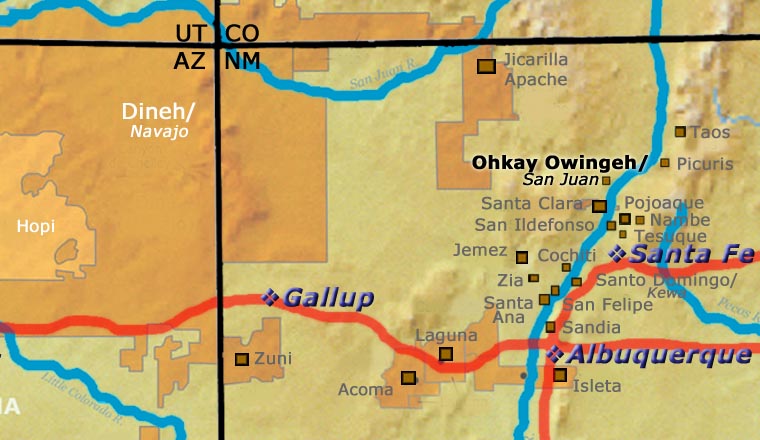
Rosita de Herrera
Ohkay Owingeh
San Juan


Rosita de Herrera was born into Ohkay Owingeh in 1940. Her mother was Tomasita Reyes Montoya. Tomasita was one of the seven Ohkay Owingeh women who redefined San Juan pottery in the 1930s. Some ancient Tewa pottery had been found on Ohkay Owingeh land on the west side of the Rio Grande and it was dated by archaeologists to have been made just prior to the arrival of the Spanish in New Mexico. They based their definition on that pottery and it became known as Potsuwi'i Incised.
They settled on decorating redware pots with a matte design band that featured the old incised designs, similar to a lot of ancient rock art found across the Southwest. Rosita and her sister, Dominguita Sisneros, grew up learning to make that style of pottery from their mother. Eventually, a second version was innovated, adding deep carved geometric designs with other colors, while keeping the polished deep red bands around the base and rim.
Rosita was active in the marketplace by the early 1970s. She mostly made incised and carved polychrome buff-on-red bowls in both Potsuwi'i styles, and some incised blackware bowls in a more recent Ohkay Owingeh style. She taught her son, Norman de Herrera, how to make pottery, too.
100 West San Francisco Street, Santa Fe, New Mexico 87501
(505) 986-1234 - www.andreafisherpottery.com - All Rights Reserved

Ohkay Owingeh (San Juan)

Ohkay Owingeh Mission
Ohkay Owingeh has a long history of pottery-making. Archaeologists even date certain timespans in the Pueblo II era by the San Juan Polychrome and San Juan Blackware potsherds that have been found in many digs. The styles were so striking for the time that archaeologists have been able to reconstruct trade routes by the date of appearance of those styles in different pueblos. But the making of pottery in the traditional way is not so widespread at Ohkay Owingeh these days.
In 2005 San Juan Pueblo officially changed its name back to the original name (before the Spanish arrived): Ohkay Owingeh (meaning: Place of the strong people). There are numerous abandoned ancient pueblos in the countryside around today's primary village of Ohkay Owingeh that have been archaeologically excavated and dated, but none of those excavations have yielded a date for the establishment of the village on the east side of the Rio Grande that was discovered by Don Juan de Oñaté in 1597.
The people of Ohkay Owingeh speak Tewa, and may have come to the Rio Grande area from southwestern Colorado or from the San Luis Valley in central Colorado. There is an archaeological record that possibly tracks their ancestors as they moved downstream through the valleys of the Ojo Caliente and Chama Rivers to the Rio Grande in the 1300 and 1400s. There is also an archaeological history showing there were Tanoan groups living in the area for hundreds of years before that.
Spanish conquistador Don Juan de Oñate took control of Ohkay Owingeh in 1598, renaming it San Juan de los Caballeros (after his patron saint, John the Baptist). He established the first Spanish capitol of Nuevo Mexico across the Rio Grande in the village of Yugue-Yunqué, an area he renamed San Gabriel. In 1608, the capitol was moved south to an uninhabited area that became the Santa Fe we know today.
After 80 years of progressively deteriorating living conditions under the Spanish, the tribe participated in the Pueblo Revolt of 1680 (one of the revolt's ringleaders, Popé, was an Ohkay Owingeh shaman) and helped to expel the Spanish from Nuevo Mexico for 12 years. However, when the Spanish returned in 1692, Popé had died, that tribal unity had collapsed and the individual pueblos were relatively easy for the Spanish to reconquer.
Today, Ohkay Owingeh is the largest Tewa-speaking pueblo (in population and land) but few of the younger generations are interested in carrying on with many of the tribe's traditional arts and crafts (such as the making of pottery, weaving of baskets and knapping of flint). The pueblo is home to the Eight Northern Indian Pueblos Council, the Oke-Oweenge Arts Cooperative, the San Juan Lakes Recreation Area and the Ohkay Casino & Resort. The tribe's Tsay Corporation is one of northern New Mexico's largest private employers. With the tribe's modern foray into casino operations, the younger members of the tribe say it's much easier to make a living flipping burgers, dealing cards or working security jobs than pursuing the production of traditional arts and crafts. This has become a problem everywhere there are Indian casinos, no matter who the tribe is.
100 West San Francisco Street, Santa Fe, New Mexico 87501
(505) 986-1234 - www.andreafisherpottery.com - All Rights Reserved

Tomasita Reyes Montoya Family Tree
Disclaimer: This "family tree" is a best effort on our part to determine who the potters are in this family and arrange them in a generational order. The general information available is questionable so we have tried to show each of these diagrams to living members of each family to get their input and approval, too. This diagram is subject to change should we get better info.
- Tomasita Reyes Montoya (1899-1978) and Juan Reyes Montoya
- Dominguita Naranjo (Sisneros)(1942-) and Juan Sisneros
- Jennifer Sisneros and Alfred E. Naranjo (Santa Clara)
- Alfred J. Naranjo
- Jeannette Teba and Steven Teba Sr.
- Steven Teba Jr.
- Veronica Teba
- Jennifer Sisneros and Alfred E. Naranjo (Santa Clara)
- Rosita de Herrera
- Norman de Herrera
Some of the above info is drawn from Pueblo Indian Pottery, 750 Artist Biographies, by Gregory Schaaf, © 2000, Center for Indigenous Arts & Studies
Other info is derived from personal contacts with family members and through interminable searches of the Internet.
(505) 986-1234 - www.andreafisherpottery.com - All Rights Reserved
